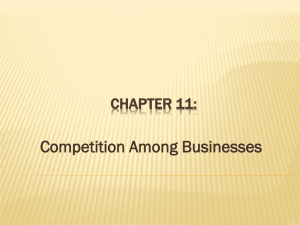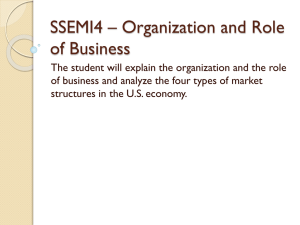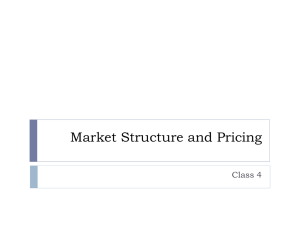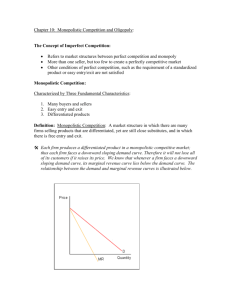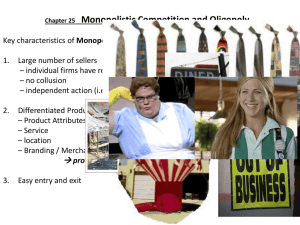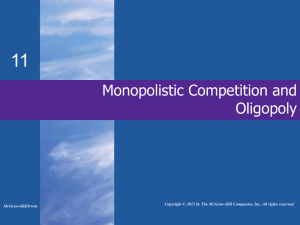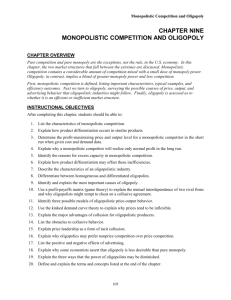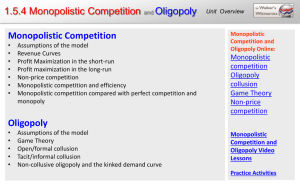Krugman AP Section 12 Notes
advertisement
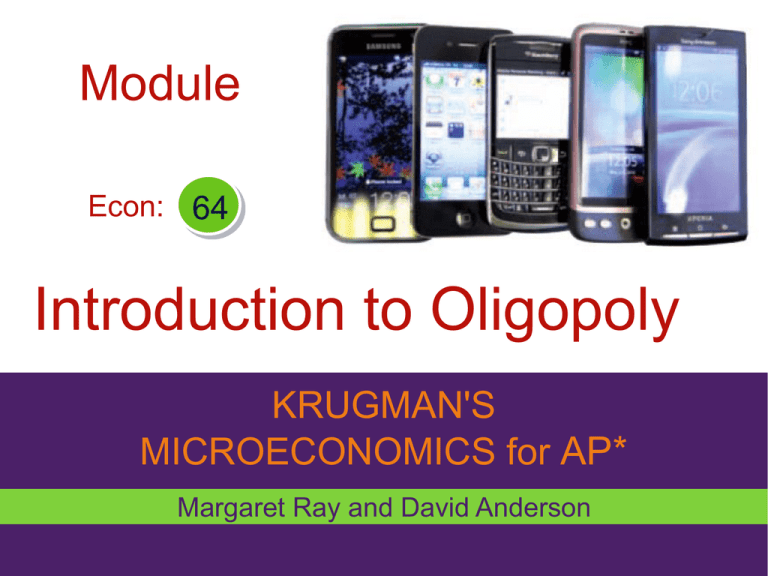
Module Econ: 64 Introduction to Oligopoly KRUGMAN'S MICROECONOMICS for AP* Margaret Ray and David Anderson What you will learn in this Module: • Why oligopolists have an incentive to act in ways that reduce their combined profit. • Why oligopolies can benefit from collusion. I. Understanding Oligopoly A. “Few” producers • Remember HHI • Page 573-74 B. InterdependenceActions of one firm have an impact on another firm and vice versa II. Collusion and Competition A. Oligopoly firms can increase their profits by colluding to restrict output or raise price. B. Maintaining collusive agreements is difficult because there is an incentive to cheat C. Collusion is illegal Price versus Quantity Competition • Bertrand • Price competition- undercut prices of competititon • Competitive outcome • Cournot • Quantity competition • Economic profits Oligopoly is a market structure that is characterized by a ______ number of ______ firms that produce ______ products. A) large; relatively small, independent; identical B) Small; independent; identical or differentiated C) Large; relatively small, independent; differentiated D) Small; independent; differentiated E) Small; interdependent; identical or differentiated Answer: E An extreme case of oligopoly in which firms collude to raise joint profits is known as a: A) Duopoly B) Cartel C) Dominant producer D) Price war E) Price leadership Answer: B Module Econ: 65 Game Theory •KRUGMAN'S •MICROECONOMICS for AP* Margaret Ray and David Anderson What you will learn in this Module: • How oligopoly can be analyzed using game theory. • The concept of the prisoners’ dilemma. • How repeated interactions among oligopolists can result in collusion in the absence of any formal agreement. I. Game Theory A. Game Theory: study of how interdependent decision makers make choices. B. When two firms are close rivals, the choices of each affect the outcomes for each. II. Non-Cooperative Games A. Each player competes to maximize individual payoffs and ignores the effects of his/her action on the payoffs received by the rival. Oligopoly Video Game Theory Practice Golden Balls B. Terms to Know 1. Payoff matrix- is a diagram showing how the payoffs to each player in a game depend on the actions of both. 2. Dominant strategy- is an action that is a player’s best action regardless of what the other player does. 3. Nash equilibrium- occurs when the game ends, and each player is happy with the outcome, given the choice made by the rival. C. Prisoner’s Dilemma 1. Each player has an incentive to choose an action that benefits his/herself at the other player’s expense. 2. Both players are then worse off than if they had acted cooperatively. The payoff matrix below summarizes the strategies and outcomes. The payoffs are measured as years in prison, so smaller numbers are preferred. Crook 2 Crook 1 Confess Silent Confess Silent #1: 5 years #2: 5 years #1: 1 year #2: 20 years #1: 20 years #1: 2 years #2: 1 year #2: 2 years D. Repeated Interaction and Tacit Collusion 1. Strategic Behavior: taking account of the effects of an action today on the future actions of other players in the game. 2. Repeated interaction can lead to strategic behavior • Tit for tat strategy 3. Tacit Collusion- cooperation among producers, without a formal agreement, to limit production and raise prices so as to raise profits. Module Econ: 66 Oligopoly in Practice •KRUGMAN'S •MICROECONOMICS for AP* Margaret Ray and David Anderson What you will learn in this Module: • The legal constraints of antitrust policy. • The factors that limit tacit collusion. • The causes and effects of price wars, product differentiation, price leadership, and nonprice competition. • The importance of oligopoly in the real world. I. Antitrust Legislation A. Laws including the Sherman Act and the Clayton Act make cartels, collusion, and certain anticompetitive business practices illegal B. Prevents Overt Collusion II. Factors Limiting Tacit Collusion (gentleman’s agreement) A. Large numbers • The more firms in the industry, the less likely tacit collusion will be successful B. Complex products and pricing schemes • It is easier to tacitly agree to keep a price high if the product is simple and there are few ways price can be set. C. Differences in interests • If firms have diverse characteristics and interests, it will be more difficult to establish and maintain tacit agreements. D. Bargaining powers of buyers • If the buyers of a product have bargaining power, or they operate in a competitive retail environment, tacit agreements to keep prices high are unlikely to succeed. III. Product Differentiation and Tacit Collusion A. Product differentiation is the attempt by firms to convince buyers that their products are different from those of other firms in the industry (either by making them different or just convincing buyers that they are). If firms can convince buyers, they can charge a higher price. B. A price leader is a firm that sets a price and the rival firms follow it. By following the leader, a tacit agreement is created. C. Non-Price competition occurs when firms compete without lowering prices; non-price competition. D. For example: Offer a warranty or better service than their rivals, offer longer hours, a charge card with rewards program, personal shoppers, or amenities like a café in the store. How Important is Oligopoly? • Prevalence in the “real world” • Difficulty of modeling oligopoly firm behavior Module Econ: 67 Introduction to Monopolistic Competition •KRUGMAN'S •MICROECONOMICS for AP* What you will learn in this Module: • How prices and profits are determined in monopolistic competition, both in the short run and in the long run. • How monopolistic competition can lead to inefficiency and excess capacity. I. Monopolistic Competition A.Characteristics in common with perfect comp.: 1. Many firms exist in the market, but not as many as perfect competition. 2. There are no barriers to entry or exit. B.Characteristics in common with monopoly: 1. The product is differentiated. 2. Each firm has some ability to set the price of their product. Ex. Local restaurants, clothing stores II. Monopolistic Competition in the Short Run A. In the short run, monopolistic competitors set price and quantity in the same way a monopoly does. B. Monopolistic competitors can earn a profit in the short run. Monopolistic Competition in the Short Run ATC C. Monopolistic competitors can also earn a loss in the short run. III. Monopolistic competition in the Long Run A. Entry and exit occur in response to shortrun profits or losses causing demand to shift B. In the long run, Monopolistic competitors earn a normal profit Comparing Monopolistic Competition with Perfect Competition • Economic profit = 0 (normal profit), so ATC=P in both due to entry and exit • MR = MC in both (profit maximization rule) • In perfect competition, ATC = P = MR = MC • In monopolistic competition ATC = P > MR = MC • Perfect competition achieves productive efficiency by producing at the minimum ATC • Monopolistic competition results in excess capacity IV. Is Monopolistic Competition efficient? A. No, P > MC so there is DWL B. BUT, variety (differentiated products) provides a benefit to consumers. Module Econ: 68 Product Differentiation and Advertising •KRUGMAN'S •MICROECONOMICS for AP* What you will learn in this Module: • How and why oligopolists and monopolistic competitors differentiate their products. • The economic significance of advertising and brand names. I. Product Differentiation A. Product differentiation is the attempt by firms to convince buyers that their products are different from those of other firms in the industry. II. Differentiation by Style or Type A. As long as consumers have different tastes, producers will be able to increase profits by differentiating their products to suit those tastes. III. Differentiation by Location A. Many monopolistically competitive firms differentiate their product by location – particularly in service industries IV. Differentiation by Quality A. Even if quality differences are mostly perceived, consumers are often willing to pay a higher price for a product they perceive to be of higher quality. V. Is Product Differentiation Efficient? A. Product differentiation can increase product variety and advertising can provide useful information, both of which can benefit consumers. B. Product differentiation can be a waste of resources and advertising can mislead consumers, both of which can be an inefficient use of resources.


